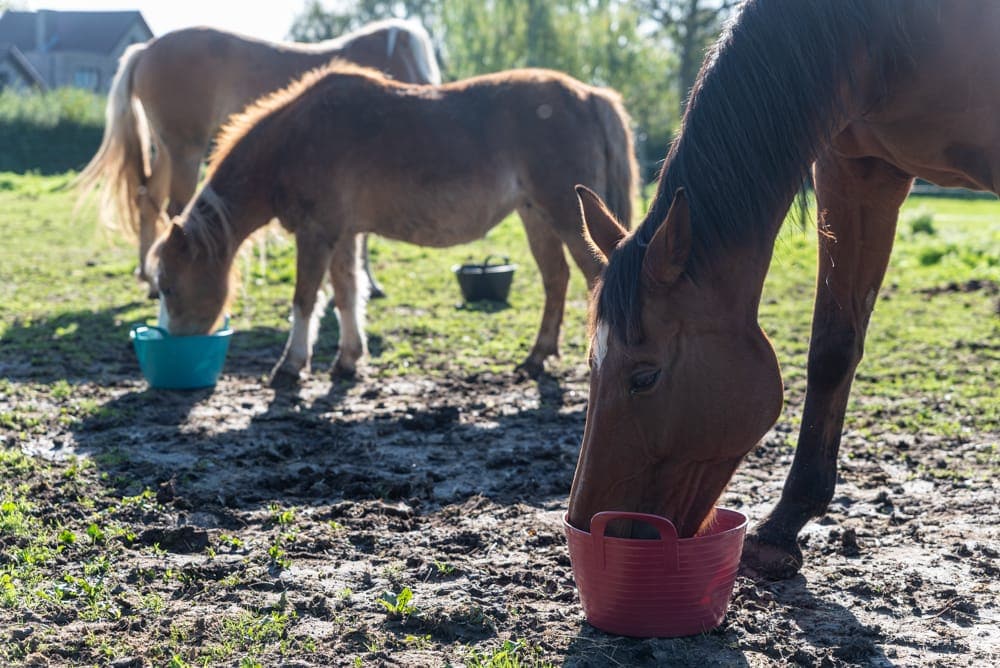
1. Free access to food: The grazing animal
Horses are continuous grazers by nature, which means their digestive system is designed to constantly process small amounts of roughage, such as grass. This is because horses in the wild typically graze for 16 to 18 hours per day. Modern feeding schedules, where horses are only fed a few times a day, can therefore lead to digestive problems such as gastric ulcers or colic.
Scientific evidence:
A study by Murray et al. (1996) examined the relationship between feeding schedules and the development of gastric ulcers in horses. The research showed that horses who went long periods without food had a much higher risk of developing gastric ulcers than horses who had regular access to roughage. The continuous production of stomach acid in horses, which is meant to digest a constant flow of grass, is one of the main reasons why regular access to roughage is crucial.
Bron: Murray, M. J., Schusser, G. F., Pipers, F. S., & Gross, S. J. (1996). “Factors associated with gastric ulcers in Thoroughbred racehorses.” Journal of the American Veterinary Medical Association, 208(1), 59-63.
2. Exercise: A Necessary Condition for Health
In their natural environment, horses travel many kilometers daily in search of food and water. This movement is essential for their physical health, particularly for digestion and hoof circulation. Modern horses kept in stables often lack this natural freedom of movement, which can lead to problems such as obesity, colic, and laminitis.
Scientific evidence:
Research by McGreevy (2004) shows that horses who get at least four to six hours of daily pasture time or free movement experience fewer health problems such as colic and obesity than horses with restricted movement. Moreover, regular movement helps support horses’ mental health by allowing them to express their natural behaviors, such as walking and social interaction with other horses.
Bron: McGreevy, P. D. (2004). “Equine behavior: A guide for veterinarians and equine scientists.” Elsevier Health Sciences.
3. Social Interaction: The Herd as an Essential Environment
Horses are social herd animals that live in groups in the wild and are highly dependent on interaction with other horses for their well-being. In a herd they experience safety, have the opportunity to display social behavior and can develop naturally. Keeping a horse alone for long periods of time can lead to serious behavioral problems, such as weaving, wind sucking and aggression.
Scientific evidence: A study by Visser et al. (2008) looked at the influence of social isolation on the behaviour of horses. The researchers found that horses that were kept isolated showed more signs of stress, such as increased cortisol levels (stress hormone), and more stereotypical behaviour than horses that lived in a herd. It is therefore very important that horses have sufficient social interaction with other horses, to reduce stress and promote their well-being.
Bron: Visser, E. K., van Reenen, C. G., Engel, B., Schilder, M. B. H., van der Werf, J. T. N., & Noordhuizen-Stassen, E. N. (2008). “The effects of social isolation on behavior and performance of mares in a novel environment.” Applied Animal Behaviour Science, 109(3), 221-234.
4. Psychological stimulation: Prevent boredom and frustration
In addition to physical needs, horses also need mental stimulation to prevent boredom. In their natural environment, horses are mentally challenged by their surroundings and interactions with other herd members. Horses that are stabled for extended periods of time can become bored, which can lead to behavioral problems such as weaving, wind sucking, and kicking at the stable doors.
Scientific evidence:
According to research by Cooper et al. (2000), horses that are kept in an enriched environment—with access to forage, social interaction, and mental challenges, such as puzzles or foraging—are less likely to develop stereotypic behaviors. Providing enrichment in the form of toys, slow feeders, branches, or opportunities to graze can therefore help support a horse’s mental health.
Bron: Cooper, J. J., McDonald, L., Mills, D. S., & Franklin, S. H. (2000). “The effect of increasing visual horizons on stereotypic weaving in thoroughbred horses.” Applied Animal Behaviour Science, 69(1), 67-83.
5. Protection against extreme weather conditions
Although horses are well adapted to cold weather conditions due to their thick winter coat, they do need protection from extreme heat, cold or rain. In their natural environment, horses can seek shelter under trees or in sheltered areas, but in a stable or pasture this can be limited. Providing shelter, such as a shelter or shelter from wind and rain, is essential to ensure the horse’s well-being.
Scientific evidence: A study by Heleski et al. (2010) showed that horses with access to shelter in the winter showed less stress and were able to regulate their body temperature better than horses without access to shelter. This confirms the importance of providing a natural environment where horses can find protection from the elements.
Bron: Heleski, C. R., Shelle, A. C., Nielsen, B. D., & Zanella, A. J. (2010). “Influence of housing on weanling horse behavior and subsequent welfare.” Journal of Applied Animal Welfare Science, 5(3), 217-231.
Conclusion
To optimally support a horse’s well-being, it is essential to take their natural needs into account. Sufficient exercise, social interaction, continuous access to food and mental stimulation are essential to prevent health and behavioural problems. Scientific research confirms that imitating the horse’s natural habitat is the key to a healthy and happy horse. By observing these basic principles, horse owners can provide their animals with the best possible care, tailored to their natural needs.